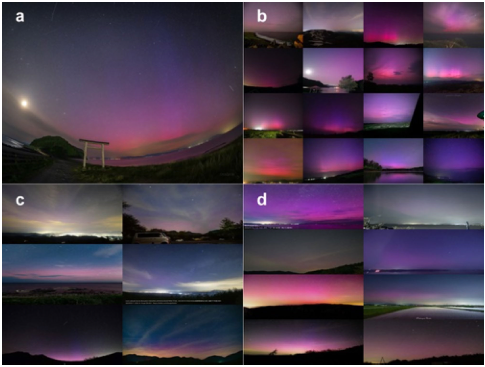Disclaimer: machine translated by DeepL which may contain errors.
The Rigakubu News
The Rigakubu News, March 2025.
The Frontiers of Research for Undergraduates >
Unraveling the mystery of aurora colors observed across Japan
Yuki Nakamura (Department of Earth and Planetary Science, Project Researcher)
On May 11, 2024, auroras were observed over a wide area of Japan.
Responding to a call on social networking sites, photos of the auroras taken by citizens were collected.
Two mysteries emerged from the photos collected by Citizen Science.
One is why the aurora was observed even in low latitude areas such as Hyogo Prefecture.
The other is why the aurora had a different magenta color than usual.
In this study, we attempted to solve these two mysteries by making full use of Bayesian inference and numerical simulation.
![]()
When the plasma flow (solar wind) emitted from the sun changes, the magnetosphere is disturbed and the ring current around the earth is strengthened, resulting in large fluctuations in the strength of the magnetic field on the ground. This phenomenon is called a magnetic storm. During a magnetic storm, energetic particles from the magnetosphere fall into the atmosphere, and auroras are often observed at high latitudes. The latitude, altitude, and color of the auroral emissions reflect the magnetospheric conditions, the type and energy of the particles, and the composition of the atmosphere, and are important clues to the origin of the aurora.
On May 11, 2024, a huge magnetic storm of the largest magnitude since November 2003 occurred. Since there was a possibility that the aurora could be observed in Japan, Associate Professor Tatsumine Kataoka of the National Institute of Polar Research (the principal investigator of this study) called for photographs via X (formerly Twitter), and as a result, aurora photos were collected from all over Japan. Two mysteries emerged regarding the auroras observed in various parts of Japan. The first is that auroras were visible even in low latitude areas such as Hyogo Prefecture. Bayesian estimation of the auroral emission latitude and upper altitude based on the upper elevation angle of the aurora in multiple auroral photographs revealed that the auroras observed in various parts of Japan were likely to have reached latitudes around 50 to 53 degrees north latitude and upper altitudes of more than 1000 km, which is much higher than usual. The upper altitude of the aurora was likely to have reached more than 1,000 km, much higher than usual. This is the reason why auroras could be observed even at low latitudes. Another mystery is that the color of the aurora was magenta, unlike the red of typical low-latitude auroras. We hypothesized that the aurora appeared magenta because of the blue emission of nitrogen molecular ions added to the red aurora, and verified this hypothesis by numerical simulations. The numerical simulation reproduced the red aurora extending to an altitude of more than 800 km due to atmospheric expansion caused by heating. On the other hand, the blue aurora was assumed to be caused by the emission of neutral particles entering the atmosphere from the ring current, but the emission was weak and did not correspond to the present aurora, as shown quantitatively. Therefore, it was concluded that the origin of the blue color is the blue scattered light produced by the resonant scattering of sunlight by a large amount of nitrogen molecular ions soaring to high altitudes, which are in the solar radiation zone even if it is nighttime on the ground.
 Photographs of the aurora borealis taken on May 11, 2024, in various locations in Japan: a, from Aomori (photo by KAGAYA); b, from Hokkaido; c, from Chubu; and d, from Tohoku (courtesy of a citizen). The magenta aurora can be seen extending high into the sky. The magenta color is thought to be formed by a combination of the red aurora caused by oxygen atoms and the blue scattered light produced by the resonant scattering of sunlight from the large amount of nitrogen molecular ions soaring in the sky. © Scientific Reports, 15, 25849 (2024)
Photographs of the aurora borealis taken on May 11, 2024, in various locations in Japan: a, from Aomori (photo by KAGAYA); b, from Hokkaido; c, from Chubu; and d, from Tohoku (courtesy of a citizen). The magenta aurora can be seen extending high into the sky. The magenta color is thought to be formed by a combination of the red aurora caused by oxygen atoms and the blue scattered light produced by the resonant scattering of sunlight from the large amount of nitrogen molecular ions soaring in the sky. © Scientific Reports, 15, 25849 (2024)The results of this study were published in Kataoka, R. et al. Scientific Reports, 15, 25849 (2024).
(Press release, October 31, 2024)


